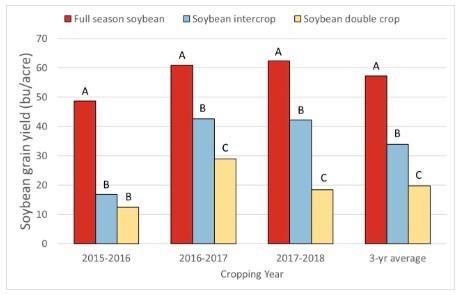By Laura Lindsey and Eric Richer
In northern Ohio, double-crop soybean production after wheat harvest needs to be carefully considered. There are both agronomic considerations (Do I have enough time and moisture to produce a soybean crop?) as well as economic considerations (Will my double-crop soybeans be profitable?). Profitability depends on soybean yield and price as well as the cost of inputs and field operations.
At the Northwest Agricultural Research Station, we compared full-season soybean (soybean only), relay-intercropped soybean (soybean intercropped into wheat), and double-crop soybean following wheat harvest (Figure 1). Across the three years of the study, soybean yield was greatest for a full-season crop (average of 57 bu/acre) and lowest for a double-crop soybean (average of 20 bu/acre). Relay-intercropped soybean yield fell in the middle with an average yield of 34 bu/acre. In 2016, soybean yield as an intercrop and double-crop were extremely low (17 and 12 bu/acre, respectively) due to hot, dry conditions that year.)

Figure 1. Soybean grain yield when grown as a full-season crop, a relay intercrop, and a double-crop at the Northwest Agricultural Research Station near Custar, Ohio. (Click here to read more about this study: https://ohioline.osu.edu/factsheet/anr-100).
While this assessment looks only at the soybean component, the profitability of the entire cropping year (wheat +soybean) may be desirable to consider when making double-cropping decisions. The profitability of these various production systems can be extremely variable depending on input, field operation, and commodity prices. We developed an excel-based calculator to help estimate profitability (https://stepupsoy.osu.edu/wheat-production/wheat-profitability-calculator). The calculator can be used to estimate a partial return of six different production systems:
- Winter wheat only
- Winter wheat + straw
- Full-season soybean (soybean only)
- Winter wheat (grown in 15-inch row width) with soybean intercropped
- Winter wheat followed by double-crop soybean
- Winter wheat + straw followed by double-crop soybean
This calculator uses default values for crop prices, input prices, field operation costs, and projected crop yield from OSU Enterprise Budgets, OSU Custom Rate Survey, and OSU field research to compare the partial return of these six production systems. However, next to each default value, you can put in your production prices and costs to customize to your farming operation. Based on our calculator’s 2022 default values, the gross return, costs per acre, and partial returns are printed in the table below.
Table 1. Partial return comparisons of six cropping systems. Default values are based on OSU Enterprise Budgets, OSU Custom Rate Survey, and OSU field research. Download the spreadsheet to edit with your values: https://stepupsoy.osu.edu/wheat-production/wheat-profitability-calculator
| DEFAULT VALUES | | | |
| | Gross Return per acre | Costs | Partial Return |
1 | Wheat only (7.5-inch row width) | $698 | $266 | $432 |
2 | Wheat only (7.5-inch row width) + straw | $956 | $279 | $676 |
3 | Full season soybean | $809 | $187 | $622 |
4 | Wheat (15-inch row width) with soy intercropped | $1,023 | $405 | $618 |
5 | Wheat (7.5-inch row width) with soy double-crop | $982 | $413 | $568 |
6 | Wheat (7.5-inch row width) with soy double-crop + straw | $1,240 | $427 | $813 |
The research used to produce this calculator tool was generously funded by Ohio Corn and Wheat.
Source : osu.edu